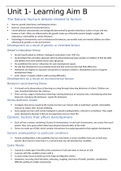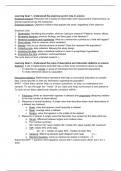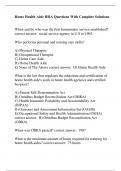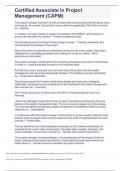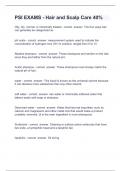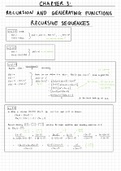Section 3: From Republic to restored and limited monarchy.
Chapter 1: Consolidation of the Republic 1649-1651 –
Rump Government:
Rump was tasked with removing the last remnants of royalism in England. It aimed at doing
this by:
1. Declaring itself as the sole legislative authority
2. Creating a council of state to act as the Privy Council
3. In March 1649, both the House of Lords and Commons were abolished
4. In May 1649 England was declared a commonwealth
The 3rd Civil War and foreign policy:
Foreign monarchs refused to recognise the legitimacy of the Rump after it had executed
Charles. In this time of uncertainty, the navy was bolstered with 20 new warships and this
helped Cromwell with his expedition to Ireland and the 3rd Civil war with the royalist scots.
What happened in Ireland?
Cromwell landed in Ireland in August 1649 with an army of 20,000 men. His aim was to get
rid of the catholic royalist sympathisers. Cromwell expected a swift victory but instead, his
victory was only achieved after storming the strongholds of Drogheda and Wexford, killing
thousands of defenders after they had surrendered. Cromwell saw this as divine providence
and he used it to justify the slaughter.
What happened in Scotland?
Cromwell returned to England in 1650 to conquer Scotland. Although the Scots were
parliaments allies, they wanted to cut all ties after the execution of Charles.
After Charles II was proclaimed King in Scotland (Feb 1649), they had made peace with the
Covenanters and then raised an army to head to England.
Two major battles define the war with the Scots:
1. Dunbar – After Cromwell marched to Scotland with 15,000 men, he defeated the
Scots at the Battle of Dunbar in September 1650.
2. Worcester – Charles II marched south a year later in hopes of gaining support.
However his troops were tired and were defeated by Cromwell’s troops on September
3rd 1651.
After his defeat at Worcester, Charles escaped to the United Provenances, where he remained
in Exile until 1660.
The Dutch:
The United Provinces was a protestant state that was the first to recognise the Rump. Despite
the Dutch and English being allies, the Navigation Act passed in 1651 resulted in the Dutch
being angry. This was because the Navigation act forbade the Dutch from using English
ports, which had a detrimental impact on the financial position of the Dutch because more of
its income came from transatlantic trade.
,Chapter 2: The Rump Parliament (1649-1653) –
Failure of radical groups:
Some groups such as the Levellers and the Quakers wanted religious toleration, even though
they got very little.
List of acts passed by the Rump in regards to religious toleration:
Act What was it?
Toleration act of 1650 Removed requirement for people to attend
church as long as they took part in a specific
religious service each week. – Those
dissenting were therefore punished.
Church tithes Nothing was done to remove church tithes
(taxes) and in April 1652, the Rump
declared that the collection of the tithes
should continue. Therefore some radical
groups were therefore paying taxes to a
parish that they would never attend.
Blasphemy Act 1650 This aimed at restricting religious radical
sects.
Sabbath Act This enforced the observing of the Sabbath
as a holy day.
Government newspaper Called ‘Mercurius Politicus’ and was
launched to defend the Rump’s actions.
Censorship This was introduced in order to limit the
spread of radical pamphlets.
Adultery Act 1650 This imposed the death penalty for adultery
but was rarely used.
Successes of the Rump Parliament:
1. Toleration Act moved for more religious toleration
2. An act ending imprisonment for debt was passed in September 1649
3. Navigation Act of 1650 meant that goods were carried on English ships, to remove
Dutch monopoly over freight trade
4. Army managed to remove the royalist influences in Scotland and Ireland
5. Hale commission created to investigate legal reform
6. Army was successful in defeating the threats from the Levellers – mutiny of Leveller
soldiers at Burford in 1649 was suppressed and led to some of the leaders being shot.
Failures of the Rump Parliament:
1. Although the Hale Commission was appointed by the Rump, it saw all of its
recommendations for legal reform rejected
2. Lack of money from taxes – couldn’t rely on political nation and therefore decided to
maintain army, so money couldn’t be diverted elsewhere
3. Rate of reform slowed down tremendously – 125 acts passed in 1649 to only 51
passed in 1652
4. As time passed, the Rump appeared more selfish and corrupt – it failed to dissolve
itself, despite promising it would. – Rump was never intended as a permanent body!
, Rump’s Dissolution:
At Whitehall on April 19th 1653, Cromwell proposed that the parliamentary system should be
put on hold and replaced with an interim government to govern while new elections were put
in place. Cromwell’s advisors gave him two options of where he could turn and he chose
Colonel T. Harrison’s idea of replacing the Rump with a parliament of ‘godly’ men
(Parliament of Saints) to govern and plan a new government to fit with the return of Christ.
(Harrison was a 5th Monarchist).
Cromwell therefore decided to replace the Rump in July 1653 with the Parliament of Saints.
Chapter 3: The Parliament of Saints, 1653, and the Instrument of Government –
The Parliament of Saints:
After it became known that the Rump was destined to fail, Cromwell was advised by 5th
Monarchist by Major General Harrison to create a godly society taking officers and members
from various churches and radical groups to come together to create an assembly of devout
men. Although the Parliament of Saints was short lived, it managed to pass numerous
progressive forms.
Successes and Failures of the Parliament of Saints:
Successes Failures
Regulations were put in place for the There were some radical members within the
treatment of lunatics Parliament – leading to nickname of
Barebones Parliament
Civil marriage was allowed, officiated by JPs The 140 members were not selected from
individual churches. The council of officers
in the army had a say and added some names.
Legal measures to help debtors were There was a clear split between the radical
introduced members and the conservatives. For example,
there was division over the issue of
abolishing tithes. Propertied members were
unhappy with their abolition.
The assembly included members from Wales,
Scotland and Ireland, thus being the first
assembly to be representative of all Britain.
Members attempted to secure trade routes by
continuing war with the Dutch.
The Instrument of Government:
The Parliament of Saints was assembled in July 1653, but it lasted barely 6 months and on
December 12th 1653, the more conservative members of the parliament met and decided to
dissolve the assembly.
Three days later, General John Lambert drew up the Instrument of Government, which was to
serve as the new Constitution.
It was modelled on the Heads of Proposals on 1647 and would serve as the basis for
Cromwell’s power
Sole executive authority was vested in Cromwell and he would run the country with
the help of a council of state of 21 members.
Parliaments were to be elected every 3 years


